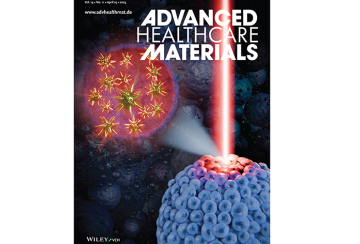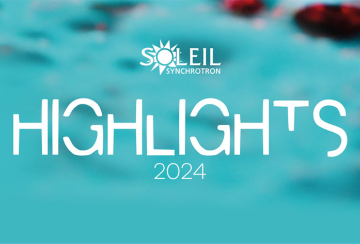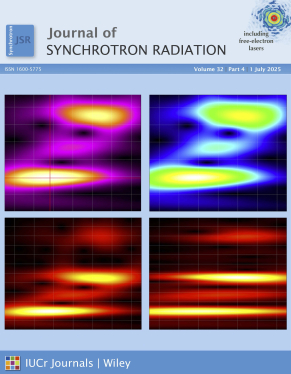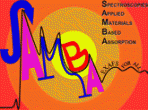
SAMBA (Spectroscopy Applied to Material Based on Absorption) is a hard X-ray absorption spectroscopy (XAS) beamline. SAMBA is open to a broad scientific community spanning from physics to chemistry, surface and environmental sciences.
SAMBA (Spectroscopy Applied to Material Based on Absorption) is a hard X-ray absorption spectroscopy (XAS) beamline. SAMBA is open to a broad scientific community spanning from physics to chemistry, surface and environmental sciences. The design of SAMBA optics is optimized in order to be very versatile and to cover the 4.8-40 keV energy range with a high flux of photons and stability and optimum energy resolution. The monochromator runs in continuous scan mode, and a 35 pixels HPGe fluorescence detector is available for measurements on highly diluted specimens.
Team

Technical data
Between 4.8 to 40 keV
Si(220) : 6x10-5 @ 15 keV
Bending Magnet Radiation (Ec = 8.65 keV) 1.5 mrd Horizontal x 1 mrd Vertical
Si(220) : 2.8x10+11 Phot/s/0.1%bw @ 15 keV
Si(220) : 2.3x10+10 Phot/s/0.1%bw @ 35 keV
A sagittal focusing monochromator between two bendable cylindrical mirrors
200x300 μm2
300x300 μm2
Ionisation chambers (Transmission)
Canberra 35-elements monolithic planar Ge pixel array detector, Multi-elements Germanium detector or a Vortex silicon drift detector (Fluorescence)
Total electron yield

Scientific opportunities
|
Material science Energy storage |
Determination of structural and electronic properties and average size of nanosystems. Dynamic or static study of new anodic or cathodic materials. Understanding of magnetic phase transition of molecular system in coordination chemistry. Characterisation of glasses, Sol-Gel etc... |
|---|---|
| Physic | Investigation of clusters embedded in matrices. |
| Biology, Biomaterials |
Study of reactivity of biomimetic compounds which are used as simple model compounds to understand the mechanism of catalysis of more sophisticated systems like metallo-enzymes. Investigation of metal ions present in metallo-proteins and in bio-inorganic complexes. |
| Earth and environmental sciences |
Local environment probe of any element in natural systems (soils, sediments, snow, plants, microorganisms ...). |
| Surface science |
Characterisation of the local structure of thin films at the very first stages of growth. Study of the interfaces : metal/metal, metal/semiconductor and oxides/metal. |
| Catalysis |
Structural and electronic characterisation of catalysts in order to understand/predict their catalytic activity/selectivity in a given reaction. (DeNOx catalysis, Fischer-Tropsch, hydrogenation of hydrocarbons ...). |
Optical Hutch
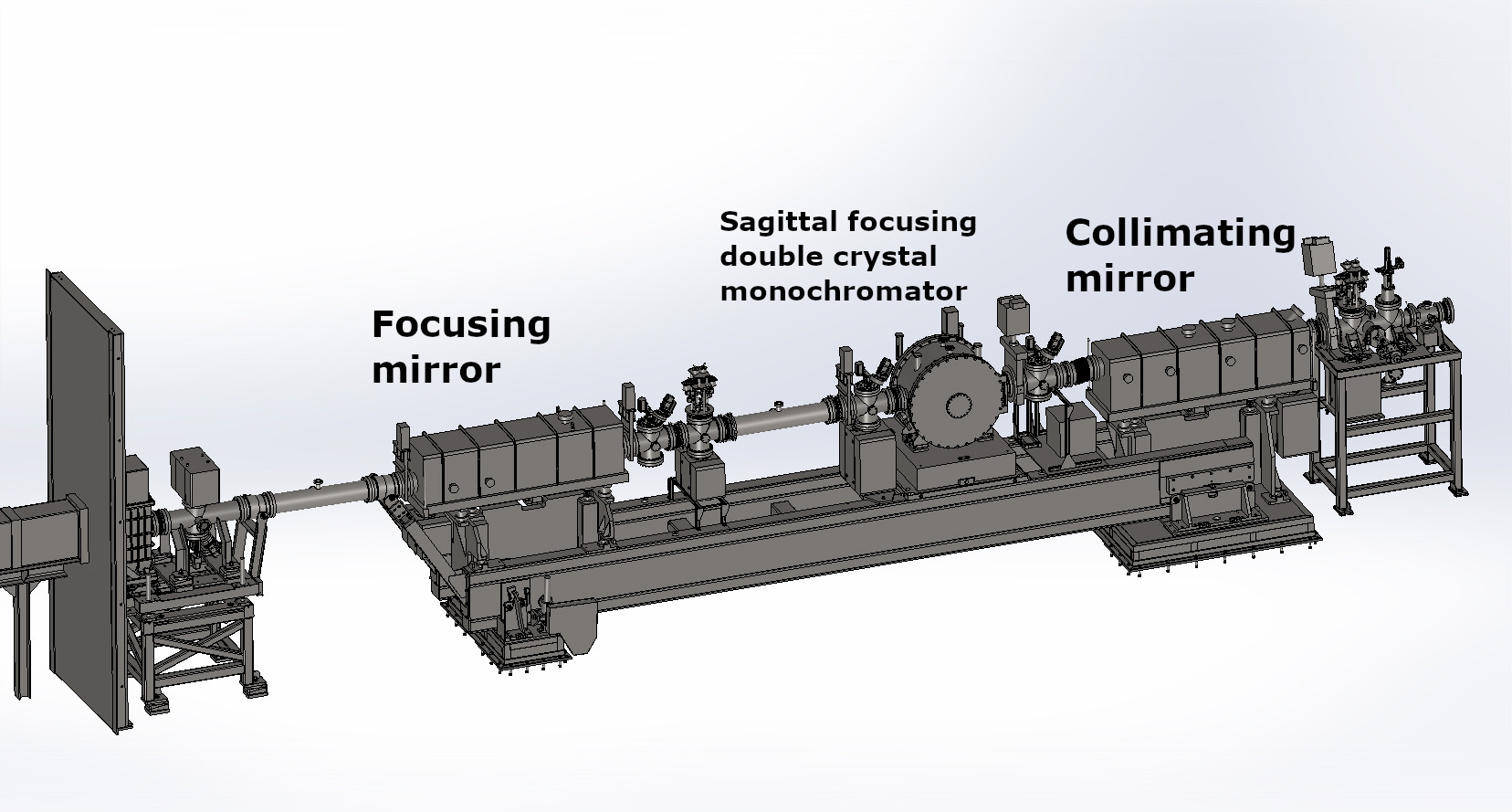
Optical layout
Mirrors
Two cylindrically bendable silicon mirrors (WinlightX) coated by a layer of 50 nm of Pd are used for providing:
- vertical collimation of the beam
- vertical focusing of the beam at the sample position
- harmonic rejection.
The mirrors are used over the whole 4-40 keV energy range available on the beamline by tilting the mirrors from 10 mrad to 1 mrad (i.e. 0.57° to 0.057°) depending on the desired cut-off energy for removing the harmonic X-rays.
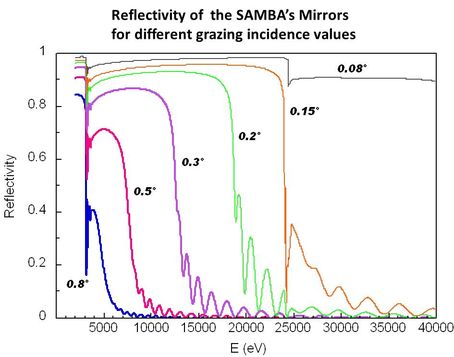
The reflective Pd surfaces are 1200 mm long per 88 mm wide allowing a horizontal acceptance of about 6.2 mrad on the first collimating mirror located at 14.1 m from the source. The surface of the mirrors was polished to a rms roughness less than 3 Ǻ rms and to a longitudinal slope error less than 2µrad rms. The first mirror is water cooled using blades immersed in In-Ga eutectic in grooves in the mirror surface.
The focusing in the vertical direction is ensured by the M2 mirror, the resulting vertical spot size at the sample position is 110 µm (FWHM) with a foot size of about 300 µm.
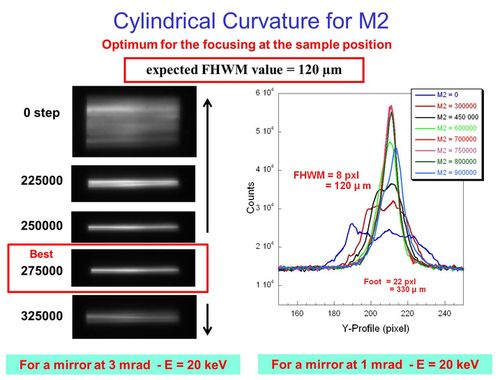
Sagittal focusing double crystal monochromator
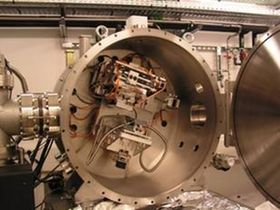
Sagittal focusing double crystal monochromator
The sagittally focusing Double Crystal Monochromator (DCM) provided by Oxford Danfysik is used in the so-called high flux mode. The DCM is installed at 16.1 m from the source. It deals of a first flat water-cooled Si(220) crystal and a sagittally bent 2nd crystal. The main Bragg axis of rotation passes through the centre of the diffracting face on the 1st crystal and perpendicular to the beam axis. In this way, the incident white beam is always centred on the axis of rotation. A fixed offset to the exit beam is achieved by moving the 2nd crystal perpendicularly to the first one according to the Bragg angle. In this case the beam moves along the axis of the sagittally-bent 2nd crystal. The first crystal is indirectly water-cooled by using a multi-channel water cooling support (SOLEIL original design) in contact with the crystal through a thin film of In-Ga eutectic. The 2nd crystal is uncooled.
The horizontal acceptance of the monochromator is limited by the efficiency of the sagittal bender. For a horizontal acceptance of 1.5 mrad, the typical beam size at the sample position is around 300 µm (H) x 200 µm (V) (FWHM).
In order to avoid possible radiation damage on the sample due to the high density of photons in a so small spot, the beamline is often slightly defocused in both directions to achieve a spot size of 2 mm (H) x 1mm (V).
The typical flux at the sample position at 8.5 keV is 5×1011 ph/s (6 mrad of vertical acceptance and 1.5 mrad of horizontal acceptance, I = 400 mA).
Related publications:
SAMBA: The 4-40 keV X-ray Absorption Spectroscopy Beamline at SOLEIL.
V. Briois, E. Fonda, S. Belin, L. Barthe, C. La Fontaine, F. Langlois, M. Ribbens, F. Villain
UVX 2010 - 10e Colloque sur les Sources Cohérentes et Incohérentes UV, VUV et X ; Applications et Développements Récents: 41-47. EDP Sciences 2011
EXAFS Hutch
Detection
Transmission :
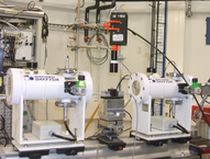 Oxford ionization chambers
Oxford ionization chambers
Fluorescence :
![]() Canberra 35-elements monolithic planar Ge pixel array detector
Canberra 35-elements monolithic planar Ge pixel array detector
 Detector Silicon Drift : Vortex
Detector Silicon Drift : Vortex
Total electron yield
The sample must be electrical conductor otherwise a thin layer of graphite may be evaporated.
Sample environments
Catalysis
Gas blower
quartz capillary oven for operando measurements up to 850°C and 10-15 bars
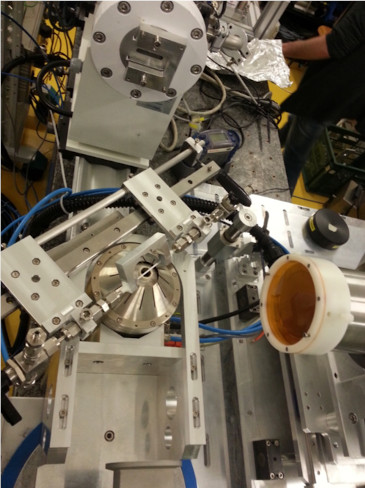
Gas distribution system
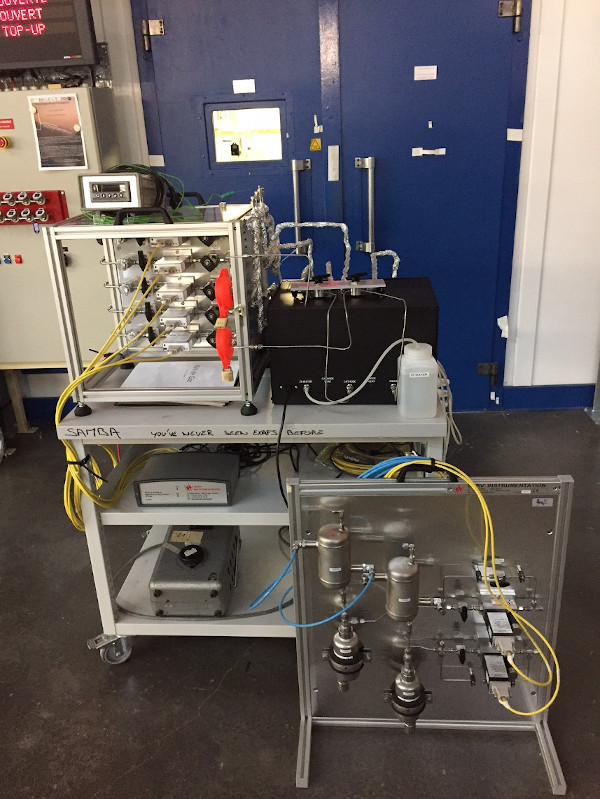
- Complex mixtures
- Humidifier
- Heated lines
- Remote control
Low temperature
He cryostat suitable for transmission and fluorescence detection (20 K to 500K). Liquid nitrogen (80 K) can also be used
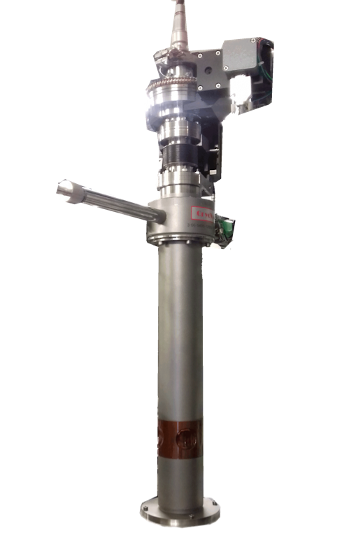
Grazing incidence
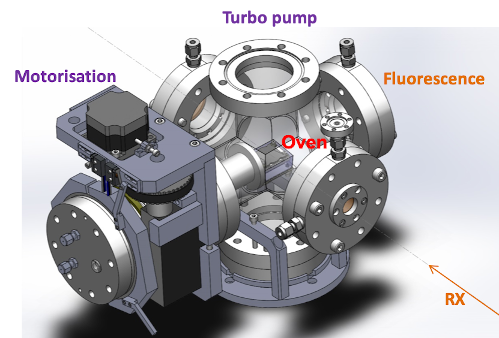
- Sample T° : 900°C
- T° Ramp : 10 à 30°C/min
- Pressure: 5.10-7mbar
- possible to work under partial gas pressure
- Modes Transmission (Reflexafs) and Fluorescence possible
Liquid Cells
We have cells with different optical path available for basic or acidic solution. Kapton, Mylar, PP or PTFE can be used as windows depending of the nature of the solution.
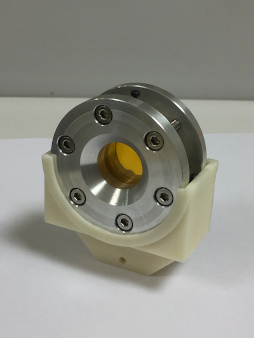
Other
The experimental hutch can host different setups and sample environments provided by the beamline, such as potentiostats, mass spectrometer, micro GC, Raman, UV-visible, differential scanning calorimeter, and other equipment provided by users. Please contact the beamline staff to discuss any other setups.
Information for the users, help for preparation and submission of proposal.
Gas
The application for the use of specialty gases must be stipulated in your proposal in order that the security service can assess the associated risks. Specialty gases must be commanded 8 weeks before your experiment, also you have to prevent your local contact well in advance, for common gases (helium, argon, nitrogen, hydrogen, air and oxygen) only 4 weeks are sufficient.
Liquid Helium
The application for the use of liquid helium must be stipulated in your proposal and recalled to your local contact in such a way to order sufficiently in advance the suitable volume. Please, given the high cost of liquid helium, carefully consider its use.
Sample positioning
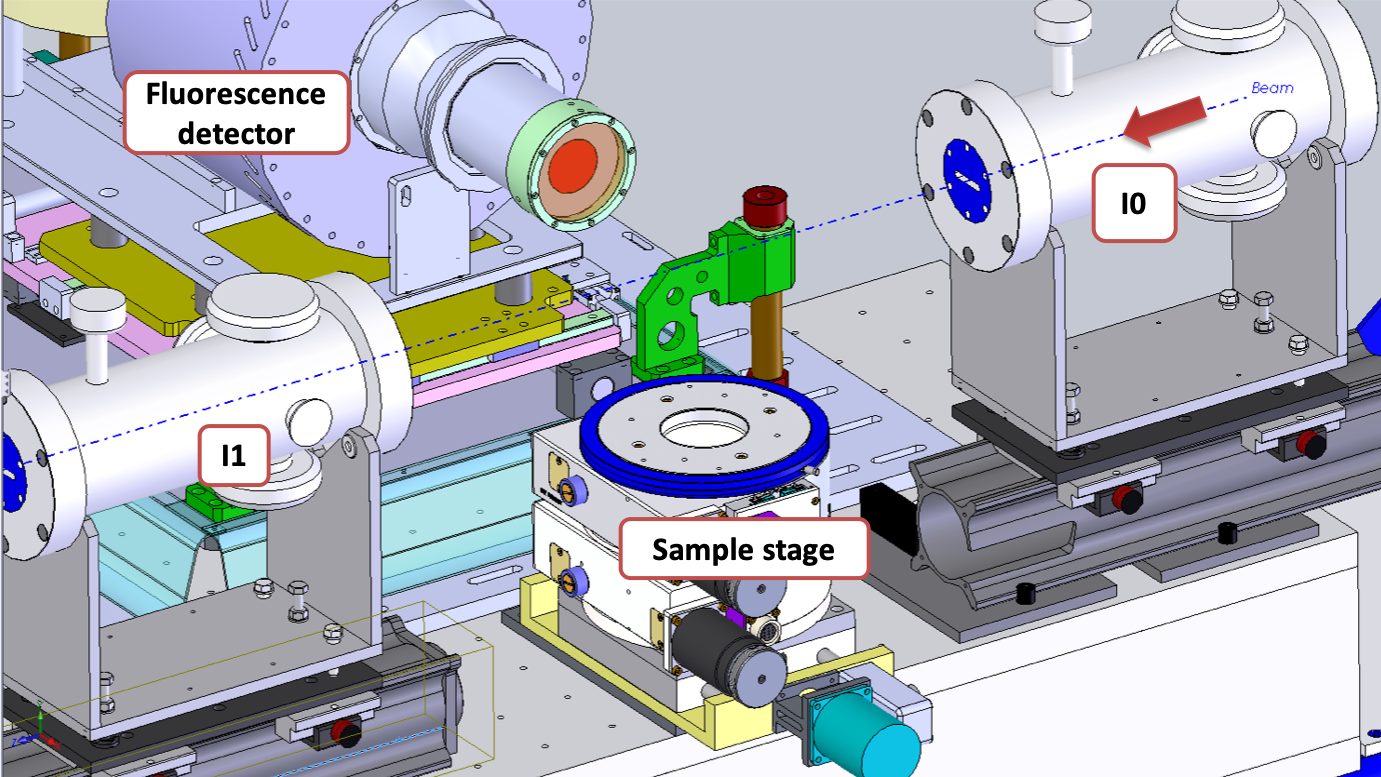
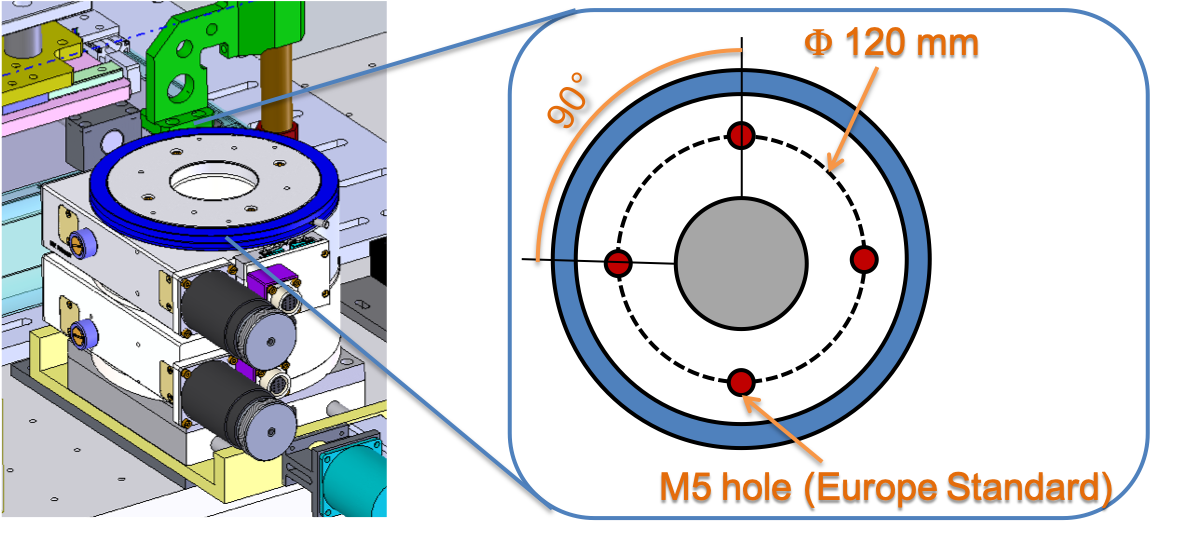
Information on project proposal submission
Beamtime Applications
Projects are examinated twice a year by an independant peer review commitee. The projects must be filled via the SunSet Application
Two important deadlines (standard & BAG project) :
15 February - 15 September
How to prepare your Beamtime application ?
Project must be written in english and submissions must comply with the following framework :
Online submission of the web form to give general information
1. Description of the scientific background and experimental part
2. Figures or images in annex (format .jpeg .png)
3. Description of experimental conditions with special safety measure
4. Submission of the proposal
(If the application constitutes the project continuation, filing in a report of the previous experiment in the SunSet and mention of related publications are necessary)
Also,
- It is strongly advised to contact one of the beamline scientist, they will assist in the definition of the setups necessary for the desired experiment and in the assessment of the best conditions.
- The justification of the required beamtime is required.
Do not forget to mention your related publications in the sunset.
For more informations : The general User's guide The general User's guide
24/06/2025
Our manuscript presenting our XAFS data treatment software « Fastosh » has been published. This is meant to be the permanent reference of the code. Please use it when citing the software.
-------------------------------
2024
Our recent paper A Novel Electrochemical Flow-Cell for Operando XAS Investigations On X-ray Opaque Supports has been selected by PCCP Editors as a 2024 HOT PCCP article. Please find the collection here

A software for XAFS data treatment, available for Windows, Mac, and Linux
Permanent reference for citation:
Landrot & Fonda, "Fastosh: a software for the treatment of XAFS datasets of environmental relevance or acquired in operando conditions", J. Synchrotron Rad. (2025). 32(4), 1085-1094
Latest release (27/11/2025): Fastosh v 1.0.10
Open the PDF file « Version description » to find out what’s new in the latest version.
Subscribe to the Fastosh Mailing List to be notified of new releases: https://groupes.renater.fr/sympa/info/fastosh
Warning: for security reasons, subscription must be confirmed a second time using the link found in the email « Subscribing to Fastosh » sent to the personal mail box after confirming subscription on the SYMPA websit
Unique functionalities for all XAFS Users:
- To rapidly upload to the program >100 XAFS spectra (ASCII or HDF5 files OK), including hyperspectral XAFS mapping data
- To automatically display averages, estimate random noise, and auto align sample & reference spectra
- To create chunk merges from a set of scans
- To perform PCA, Target Transformation, or MCR-ALS
- To do Linear Combination Fitting on a sample with multiples sets of references, or multiple samples with a set of references
- To smooth a data set using a 2D (energy & tile directions) filter
- To deglitch scans using multiple approaches
- To easily create 3D plots
- To Fourier or Wavelet Transform the EXAFS, and interpret the chi, FT, & WT map using a tool based on FEFF8L (included in Fastosh)
Specific functionalities for SAMBA Users:
- To visualize and exploit all fluorescence data saved in SAMBA HDF files
- To extract artefact-free, optimized XAFS spectra using fluorescence detector pixel & MCA data
- To access to all contextual info relative to each spectrum (motor positions, scan & dcm parameters, etc…)
- To plot the data corresponding to any ascan & dscan collected during a beamtime, using a simple interactive window
Mac Installer
Linux Installer
Version Description (PDF)
EXAFS Wavelet Transform maps created in Fastosh:
(cover of J. Sync. Rad.'s July 2025 issue):

